Many years ago, when I used to work in Kolkata, I used to commute regularly between Howrah and Kharagpur. The drill was something like this. After reaching Howrah station and buying my ticket, I walked down to the extreme left end of the station. By then a large crowd has already assembled at a strategic location from where one can see the electronic display as well as reach any of the potential platforms where the train is expected to arrive which is almost impossible to predict. Suddenly the huge crowd starts moving in a massive frenzy. This usually means that the electronic board has displayed the desired information. Travelling light is extremely important, since in that tsunami, it is extremely important that you do not disturb the stream line motion. A huge luggage, or a slow moving elderly can create a massive turbulence. And then when the train arrived, one needs to prepare himself for the next battle – to get onboard and then to get a seat. Continue reading
Tag Archives: train
Rajar Chithi : A Playwright’s Note
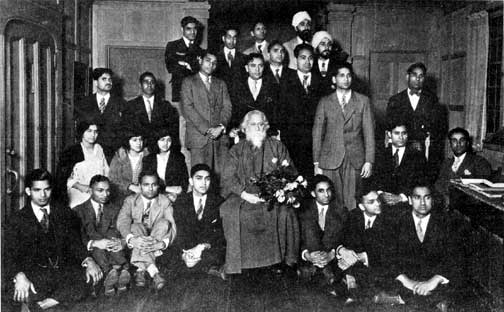 About a year and half ago, when I was researching on Rabindranath Tagore’s visits to the USA, an incident caught my attention. It said, that apparently there was an assassination attempt on Rabindranath by some Indians during his visit to San Francisco in October of 1916. This piece of information shocked me to say the least and I started to dig into the matter further. I looked into several books on Tagore by well regarded scholars and slowly an image started to take shape. I’ll refrain myself from getting into the details of the various accounts published in several books (you may look for them in the attached bibliography), but just to put matters in context I’ll quote some references: Continue reading
About a year and half ago, when I was researching on Rabindranath Tagore’s visits to the USA, an incident caught my attention. It said, that apparently there was an assassination attempt on Rabindranath by some Indians during his visit to San Francisco in October of 1916. This piece of information shocked me to say the least and I started to dig into the matter further. I looked into several books on Tagore by well regarded scholars and slowly an image started to take shape. I’ll refrain myself from getting into the details of the various accounts published in several books (you may look for them in the attached bibliography), but just to put matters in context I’ll quote some references: Continue reading Kathak in America – The Story of Kalamandir
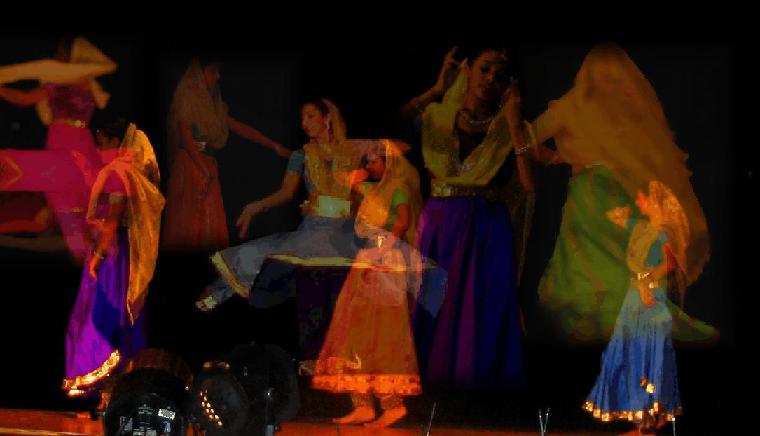 The classical Indian dance form Kathak is now quite well known amongst the dance connoisseurs of America. Americans who have some familiarity with classical music and dance of India, know about Kathak – a dance form that truly blends together the various components of Indian music – melody, rhythm and the beauty of the physical form. It is true that many stalwarts of the Kathak dance form like Pandit Birju Maharaj and others have graced the American stage with their amazing performances, but the primary reason for its popularity and sustenance in this country is due to the tremendous efforts put in by several Kathak dance schools and academies run by the immigrant dancers from India who wanted to spread their passion for this art form amongst the next generation. Once such school is Kalamandir of New Jersey led by its director, Malabika Guha.
The classical Indian dance form Kathak is now quite well known amongst the dance connoisseurs of America. Americans who have some familiarity with classical music and dance of India, know about Kathak – a dance form that truly blends together the various components of Indian music – melody, rhythm and the beauty of the physical form. It is true that many stalwarts of the Kathak dance form like Pandit Birju Maharaj and others have graced the American stage with their amazing performances, but the primary reason for its popularity and sustenance in this country is due to the tremendous efforts put in by several Kathak dance schools and academies run by the immigrant dancers from India who wanted to spread their passion for this art form amongst the next generation. Once such school is Kalamandir of New Jersey led by its director, Malabika Guha.
Cartoon of the Week 15: Train Travel
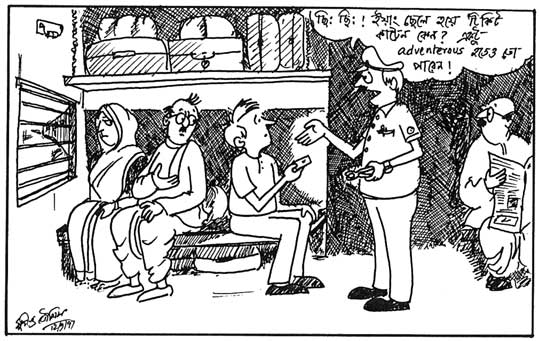 Traveling long distance by train was one of the most enjoyable modes of transportation in India. Once you get over the initial hurdles of getting a reserved seat or squeeze yourself in through the crowded doors as the train slowly rolls in to the platform or the frantic attempts to manage the porter and the family, the journey becomes much easy and enjoyable. Overnight train rides are especially thrilling when you not only need to manage a berth to sleep, but also keep an eye on your luggage and belongings to protect them from the “highly suspicious” co-passengers around you. When I was a child, I remember the train journeys from Kolkata (Sealdah or Howrah depending on which train you take) to Siliguri. Before the Farrakka bridge (barrage) was completed, we had to get off the train at Farakka and then take a steam boat across the Ganges to the other side (Sagrikoli Ghaat) and then scramble on to the train after a long run. If you were unlucky enough of not having a proper reservation, then your plight can only be imagined by those who took that journey. However, once you are settled in your seats or berths, temptations start knocking on your senses as the aroma of hot food attracts your attention along with the loud marketing attempts by the food vendors on the station. The appetizing offerings of “Ilish Maachher Jhol”, “Bhaaja Mooger Daal”, “Gorom Bhaat with Ghee” and “Begun Bhaja” pulls in many hungry passengers to the bamboo and hay thatched eateries all around the train station. Continue reading
Traveling long distance by train was one of the most enjoyable modes of transportation in India. Once you get over the initial hurdles of getting a reserved seat or squeeze yourself in through the crowded doors as the train slowly rolls in to the platform or the frantic attempts to manage the porter and the family, the journey becomes much easy and enjoyable. Overnight train rides are especially thrilling when you not only need to manage a berth to sleep, but also keep an eye on your luggage and belongings to protect them from the “highly suspicious” co-passengers around you. When I was a child, I remember the train journeys from Kolkata (Sealdah or Howrah depending on which train you take) to Siliguri. Before the Farrakka bridge (barrage) was completed, we had to get off the train at Farakka and then take a steam boat across the Ganges to the other side (Sagrikoli Ghaat) and then scramble on to the train after a long run. If you were unlucky enough of not having a proper reservation, then your plight can only be imagined by those who took that journey. However, once you are settled in your seats or berths, temptations start knocking on your senses as the aroma of hot food attracts your attention along with the loud marketing attempts by the food vendors on the station. The appetizing offerings of “Ilish Maachher Jhol”, “Bhaaja Mooger Daal”, “Gorom Bhaat with Ghee” and “Begun Bhaja” pulls in many hungry passengers to the bamboo and hay thatched eateries all around the train station. Continue reading

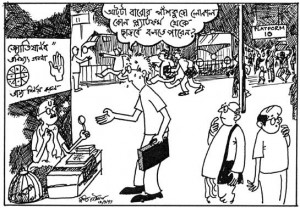
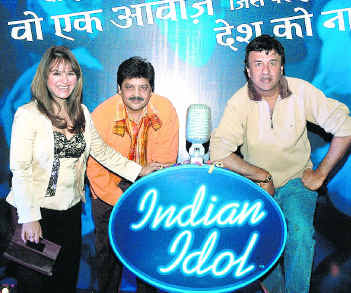 The reality TV show “American Idol” has triggered a new trend – Idol search! TV channels all over the world are searching for idols – or talents. This search is not only limited to the television screen, but it has also proliferated onto the stage in various forms. Although the primary objective of this kind of shows is to screen for talent, in reality (excuse the pun) it is nothing but an entertainment show. The excitement, the drama, and the occasional emotional outbursts, are all part of the show. Undoubtedly, such shows do bring many talented men, women and children to the limelight, but is this the right way to do explore talent? In many cases, the exploration turns to exploitation – especially for the young participants. They have to go through a grueling screening process, sustain a tremendous pressure to perform, and then handle a barrage of criticism from the celebrity judges. I know in one dance show, a young girl couldn’t take the judges criticism anymore and had a nervous breakdown resulting in a paralytic fit. In several instances the young competitors sacrifice their education to continue the show. But the tragedy is, in most cases the winner is not judged by the celebrity panel whose criticism these young participants have to encounter, but rather by the audience through cell/mobile phone text messages (SMS). And in this process, the wireless carrier mints money. I am sure the show also gets their share of this income too.
The reality TV show “American Idol” has triggered a new trend – Idol search! TV channels all over the world are searching for idols – or talents. This search is not only limited to the television screen, but it has also proliferated onto the stage in various forms. Although the primary objective of this kind of shows is to screen for talent, in reality (excuse the pun) it is nothing but an entertainment show. The excitement, the drama, and the occasional emotional outbursts, are all part of the show. Undoubtedly, such shows do bring many talented men, women and children to the limelight, but is this the right way to do explore talent? In many cases, the exploration turns to exploitation – especially for the young participants. They have to go through a grueling screening process, sustain a tremendous pressure to perform, and then handle a barrage of criticism from the celebrity judges. I know in one dance show, a young girl couldn’t take the judges criticism anymore and had a nervous breakdown resulting in a paralytic fit. In several instances the young competitors sacrifice their education to continue the show. But the tragedy is, in most cases the winner is not judged by the celebrity panel whose criticism these young participants have to encounter, but rather by the audience through cell/mobile phone text messages (SMS). And in this process, the wireless carrier mints money. I am sure the show also gets their share of this income too.